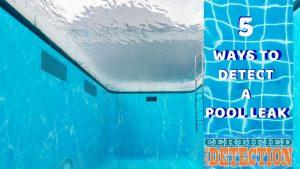
If you have a swimming pool, you might be aware that it loses some water due to evaporation, splash out and backwashing. It is normal for a pool to lose some water each day. But if your pool water level drops quickly, it’s cause for concern because it means that there is a leak somewhere in the pool. For example, losing a half-inch or inch of water in a day is indicative of a leak.
Unattended leaks not just increase your monthly water bill, but can also weaken the subsoil below the pool, which can cause damage to the pool wall. Obviously, it is important to locate the leak and have it repaired as soon as possible.
Fortunately, there are easy ways to determine if your pool has a leak. Certified Leak Detection makes these methods available on our website for easy access at any time. The popular evaporation test – otherwise known as the bucket test – is typically the first DIY leak detection step that pool owners take.
The bucket test
This test requires materials you probably already have: a 5-gallon bucket and a marker or painter’s tape. Turn off the system for at least 24 hours. This test is creating two surface areas of water to test the level of the water itself.
- Fill the bucket up to 3-inches from the top.
- Set the bucket on the second step if possible, making sure the water level is higher inside the bucket. This helps prevent the bucket from floating in the pool.
- Make a mark both inside and outside the bucket to indicate each water level. Make sure the pump is turned off for the measurement.
- Wait 24 hours to measure the change in water level for both marks.
If each level measures the same amount of change, you do not have a leak. If the difference on the outside of the bucket in the pool is greater than the inside of the bucket, you do have a leak. This indicates that your pool has lost more water through leaking than by the natural occurrence of evaporation. It is also a good sign that you need a pool repair service.
How to isolate pool leaks with food coloring
Turn off the pool pump and skimmer. Take a small squeeze bottle and fill it up with water. Next, add a few drops of red food coloring to the squeeze bottle. Once the water settles, place a few drops of colored water into the pool. You can start from the steps and check for leaks in the pool. If there is a leak in your pool, you will see the colored water leaving the pool from that area. You can put additional drops of colored water into the pool around areas where you think there might be a leak like a skimmer gasket, light fixtures, and the drain opening.
Checking the vinyl liner
For in-ground pools with a vinyl liner, check for leaks in the liner. There could be a hole in the bottom of the vinyl liner, especially if the floor feels squishy beneath your feet. If there is a leak, and the water keeps moving out, it can loosen the sand base below where the vinyl liner rests on the ground. If you suspect a leak on the floor of the pool, you perform the food coloring test to locate its exact position. Dispense a few drops of colored water on the area where you suspect the leak, and the dye will soon exit from the location of the leak.
Checking the electrical system
When you set out to detect a leak in your swimming pool, you should also check the electrical and plumbing systems. Watch for moisture or leaks at the electrical conduit lines that come from the pool’s lights. If you see water or moisture on the wires, it means there is a leak. If this is the case, call a professional to determine the precise location of the leak and repair it to avoid risk of electrical shock.
Turn off the filtration to check if there is a leak in the plumbing system. Check the pipes, fittings, and the pump for moisture or leaks. Moisture in any of these areas indicates a leak.
Calling in a professional
Finding a leak in your swimming pool can be a difficult job. Some leaks are easy to find, but there are many that pool owners can’t detect without professional assistance. Certified Leak Detection uses technology and techniques we have developed over 20 years in business. In addition to quick detection and repair of swimming pool leaks, we provide industry-leading leak detection and repair for spas and hot tubs, as well as slabs and foundations. Serving areas throughout Central Florida – including Orlando, Longwood, Lake Mary, Sanford, Kissimmee, Clermont and Winter Springs – our team is ready to answer your call.
Contact us for quick, reliable service.

